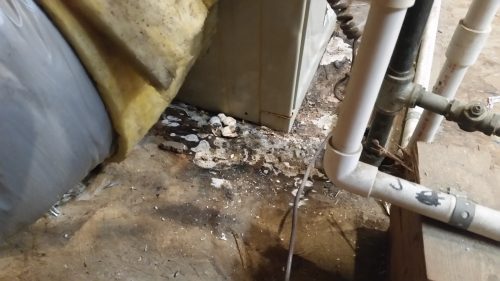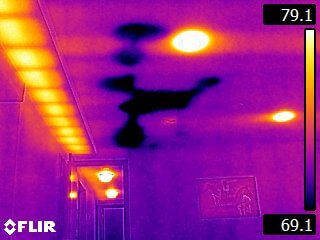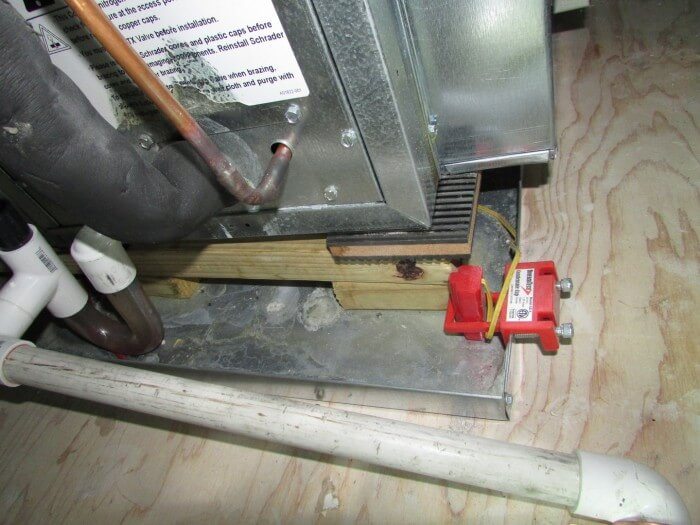In last week’s blog post about three simple AC maintenance items, one of the items I mentioned was to check on your AC condensate drain line regularly. Condensate clogs can lead to a mess, but it’s usually not a catastrophic issue. For most Minnesota homes, the condensate collection part of our air conditioners sit in the basement. If we have a condensate leak, it’s usually not going to damage the structure. But I said most. There are a good number of older homes with boilers, and these systems often have a retrofit AC system with the air handler located in the attic. When these things leak, it leads to a big mess.
The image above shows an example of a rotting subfloor in an unfinished attic caused by a leaking AC condensate drain. The image below shows an AC condensate leak with an infrared camera; the dark blue spots show water in the ceiling. No good.
In a case like this, where a condensate leak could create damage to a building, there are special requirements to help keep the building safe from harm.
Here in Minnesota, we can find these under section 307.2.3 of the 2020 Minnesota Mechanical Code. If you’re somewhere else in the country that uses the International Residental Code, you can find almost the same language under section M1411.3.1. You can click on either of my links to read the exact code language, but I’m going to paraphrase what it says to make it a little easier to understand. I am leaving out some info, so read the real code section if you want to know every little detail.
There are four options for dealing with condensate. They’re not listed in this order in the mechanical code though; I re-arranged the order because I think it makes more sense to read it this way. You can do any of these four options:
1. A drain pan with a separate drain – A separate drain pan can sit underneath the unit, and this drain pan needs to have its own separate drain line. This pan needs to be at least 1-1/2” deep, and must be at least 3” wider in every dimension than the condenser unit. The drain for this drain pan needs to terminate at a conspicuous location; it can’t just drain to a floor drain or to the outdoors. The purpose of this is to alert someone that water is coming out of someplace where it shouldn’t, and there’s a problem. Ideally, someone would go check it out and clear the clog that’s causing condensate to leak to an unusual location.
2. A drain pan with a shutoff device – a pan with the same dimensions as listed above can be installed without a secondary drain, provided there’s a shutoff device installed that meets UL 508. I don’t own that standard and I don’t know what it says, but I’ve seen plenty of these shutoff devices, and they’re pretty simple. They sit inside the drain pan or they’re mounted to the side of the drain pan. It’s that red device in the photo below. That particular one is called the Condensate Cop.
If water fills up the pan, a float shuts off the air conditioner before the water overflows. These devices are quite simple and effective, and we see a lot of them in Minnesota attics.
3. A shutoff device – a shutoff device for the air conditioner may be installed all by itself. If this is done, it needs to be installed “in the primary drain line, the overflow drain line, or in the equipment supplied drain pan.” It needs to be installed above the primary condensate drain line connection, and below the overflow rim of the primary drain pan.
4. A separate overflow drain – a separate overflow drain line can be connected to the secondary drain opening that is built into the equipment. When this is done, it needs to drain to a conspicuous location, again, to alert the occupants to a problem.
When we come across an air conditioner in an attic, we expect to see one of these four options used to help prevent damage to the building.



